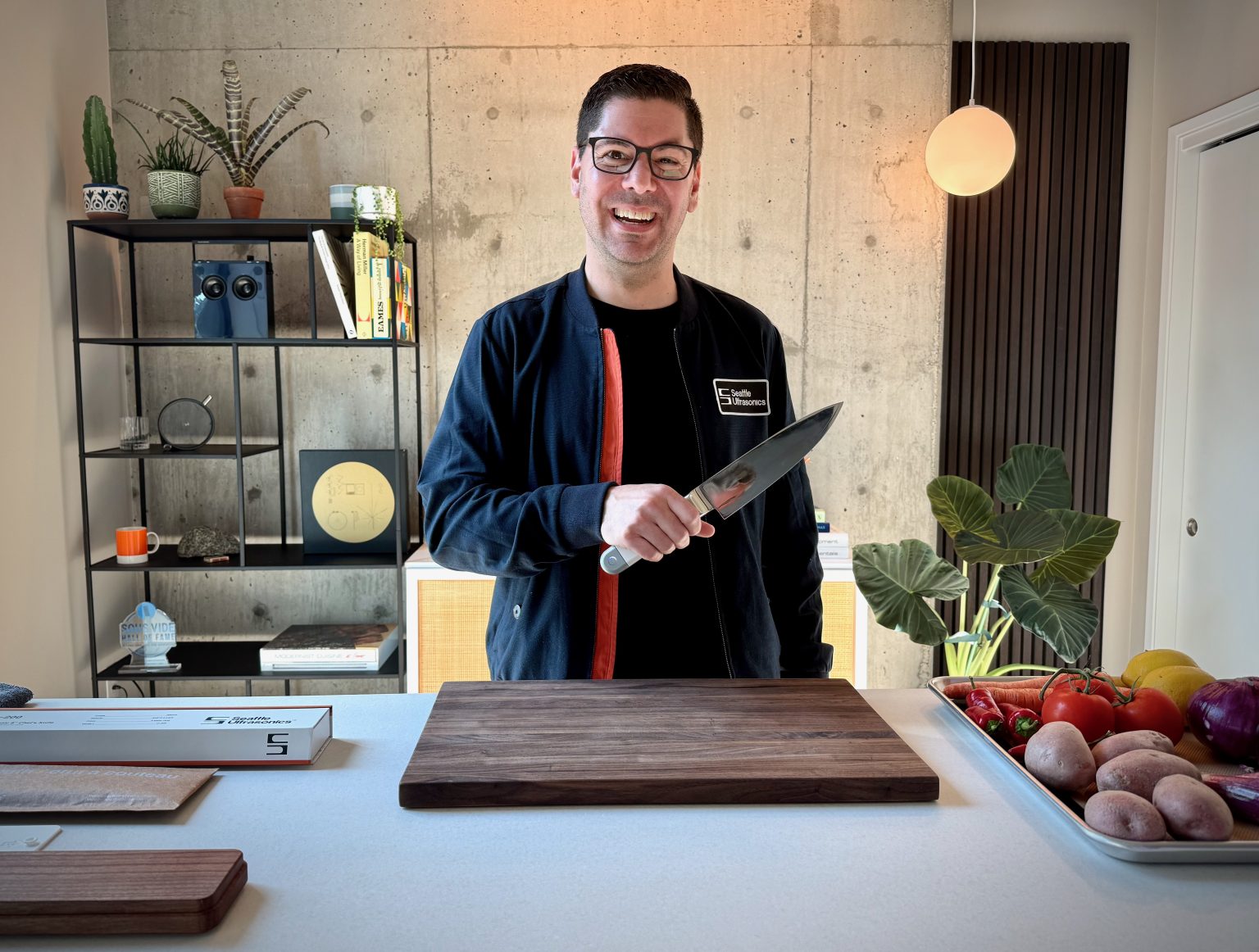Revolutionizing the Kitchen: Seattle Ultrasonics’ Ultrasonic Chef’s Knife
In the heart of downtown Seattle, Scott Heimendinger proudly displays his creation—an ultrasonic chef’s knife that represents a significant leap in culinary technology. As the founder and CEO of Seattle Ultrasonics, Heimendinger has dedicated years to revolutionizing a tool that has remained fundamentally unchanged for millennia. “It’s taken more than 2.5 million years to get from the earliest sharpened-stone version of a knife to what we have today,” he notes, holding the sleek C-200 knife that embodies his vision for the future of kitchen tools. This 8-inch chef’s knife, billed as the world’s first ultrasonic culinary blade, builds upon Heimendinger’s impressive 15-year career innovating in food technology. His résumé includes pivotal roles as director of applied research for Modernist Cuisine, CMO and chief innovation officer for Anova, and founder of the sous vide startup Sansaire—experiences that have culminated in this groundbreaking product.
The C-200 knife, priced at $399, may raise eyebrows when compared to traditional high-end chef’s knives that typically max out around $170. However, what sets this knife apart isn’t just its premium Japanese san mai AUS-10 steel blade, but rather its revolutionary handle. The technology packed into this handle produces over 40,000 vibrations per second, making the knife behave significantly sharper than its physical edge alone would allow. The only visible indication of this advanced technology is a simple power button that the chef holds while cutting. Heimendinger emphasizes that this isn’t technology for technology’s sake—a refreshing perspective in an era when many kitchen gadgets incorporate WiFi and other smart features with questionable utility. “If it didn’t make the tool work better, I would have abandoned the product, because it’d be dishonest,” he states firmly, demonstrating his commitment to meaningful innovation rather than superficial tech integration.
What truly distinguishes Heimendinger’s approach is his dedication to empirical validation. Rather than relying on subjective claims about his knife’s superiority, he built a robotic testing apparatus—affectionately named J Robot Choppenheimer—to gather objective data. This robotic arm performed identical slicing motions across 21 of the most popular chef’s knives, cutting through various foods mounted on 3D-printed holders positioned on sensitive scales. The process generated an impressive 100,000 data points, analyzing factors like edge angle and retention as part of what Heimendinger calls the “Quantified Knife Project.” True to his background as a former Microsoft program manager who worked on products like Excel, he emphasizes the importance of data-driven development: “If I was gonna try to make a knife better, first I needed to understand, ‘better than what?'” This scientific approach led him to perfect the blade vibrations facilitated by the handle’s piezoelectric crystals, resulting in a knife that requires significantly less downward force to cut through everything from tomatoes to bread loaves.
The journey to bring the ultrasonic knife to market has been a five-year endeavor for Heimendinger, fueled by $2 million in pre-seed funding. The knife represents a truly global product, with three-layer Japanese steel fabricated into blades in China before being assembled with electronics and packaging in Malaysia. Despite challenges like international tariffs, Heimendinger remains committed to the Eames design philosophy of making “the best for the most for the least.” The knife is now available through the Seattle Ultrasonics website, with additional options like a sleek wall-mounted charging tile selling for $150 (currently available bundled with the knife for $499). The chef’s knife represents just the beginning of Heimendinger’s vision—he selected it first because of its status as a kitchen workhorse, but plans already exist for a full lineup including bread knives, santokus, and vegetable cleavers. The only limitation appears to be with smaller implements like paring knives, where the electronics-filled handle can’t be significantly reduced in size.
Heimendinger’s ambitions extend well beyond knives. “I think in the long term, the sonification of the kitchen could be a thing,” he explains, hinting at a comprehensive product roadmap filled with ultrasonic innovations. One such concept, already documented in a patent filing, is an ultrasonic ice cream scoop. “Imagine just having less friction, being able to break up those ice crystals,” he says, painting a picture of how this technology could transform even the simplest kitchen tasks. However, he remains grounded in the present challenges, acknowledging that “it’s gonna take years to get through all of that, and there’s a lot to do in knives before we even get there.” This practical perspective balances his innovative vision with the realities of product development and market introduction.
Seattle Ultrasonics represents a fascinating intersection of culinary tradition and cutting-edge technology. Heimendinger’s background—spanning from Microsoft’s software development to the avant-garde culinary techniques of Modernist Cuisine—has uniquely positioned him to reimagine kitchen tools from first principles. What makes his approach particularly compelling is the focus on functional improvements rather than merely adding technological bells and whistles. The ultrasonic knife doesn’t require an app or WiFi connection; it simply performs its fundamental job better through thoughtful application of technology. As home cooking continues to evolve, with consumers increasingly interested in both traditional techniques and innovative tools, Heimendinger’s vision for “sonification of the kitchen” could represent the next significant evolution in how we prepare food. By starting with the chef’s knife—perhaps the most essential and universal of all kitchen implements—Seattle Ultrasonics has made a bold statement about how technology can enhance even our most basic culinary interactions, promising a future where cooking is not just easier but more enjoyable for home cooks of all skill levels.


